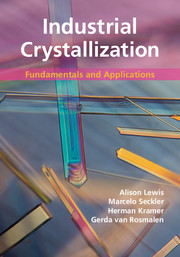Book contents
- Frontmatter
- Contents
- Nomenclature
- Industrial crystallization in practice: from process to product
- 1 Thermodynamics, crystallization methods and supersaturation
- 2 Characterization of a crystalline product
- 3 Basic process design for crystallization
- 4 Nucleation
- 5 Crystal growth
- 6 Agglomeration
- 7 The population balance equation
- 8 Batch crystallization
- 9 Measuring techniques
- 10 Industrial crystallizers
- 11 Precipitation and anti-solvent crystallization
- 12 Melt crystallization
- 13 Additives and impurities
- 14 Polymorphism
- Index
- References
2 - Characterization of a crystalline product
Published online by Cambridge University Press: 05 July 2015
- Frontmatter
- Contents
- Nomenclature
- Industrial crystallization in practice: from process to product
- 1 Thermodynamics, crystallization methods and supersaturation
- 2 Characterization of a crystalline product
- 3 Basic process design for crystallization
- 4 Nucleation
- 5 Crystal growth
- 6 Agglomeration
- 7 The population balance equation
- 8 Batch crystallization
- 9 Measuring techniques
- 10 Industrial crystallizers
- 11 Precipitation and anti-solvent crystallization
- 12 Melt crystallization
- 13 Additives and impurities
- 14 Polymorphism
- Index
- References
Summary
Why this chapter is important
In a competitive market a product has to meet increasingly stringent quality demands, so a number of particle characteristics must be carefully controlled, such as:
• crystal size distribution of the product
• shape of the crystals
• occurrence of polymorphism
• mother liquor inclusions in the crystals
• uptake of impurities in the crystal lattice
• degree of agglomeration.
These characteristics determine most functional features of particulate materials during their use as products. In the food industry, for example, both the size distribution and the shape of ice crystals in ice cream are important (Myerson, 2001). The mean size of the ice crystals should be between 35 and 40 μm in order to give the required smooth texture and melt properties, whilst the crystals themselves must be round and smooth in order to give the correct mouthfeel. Obviously the impurity concentrations in food products must be very carefully controlled.
In the pharmaceutical industry, because of the final use of the compounds, strict specifications as regards size, morphology, dissolution properties and polymorphic form are enforced.
In the bulk chemical and extractive metallurgy industries, the “particle design” is crucial (Söhnel and Garside, 1992). The crystal size distribution and corresponding particle surface area are of particular importance, since these, together with the particle morphology, have a major impact on the particle processing characteristics. For example, solid–liquid separation by centrifugation or filtration, drying rates, particle flow properties, bulk density and thus packing characteristics, as well as propensity to cake are all critically dependent on these particle properties (Söhnel and Garside, 1992).
Crystal size distribution (CSD) or particle size distribution (PSD)
One of the main characteristics of a product is its crystal size distribution or, in the case of agglomerated or non-crystalline particles, its particle size distribution.
- Type
- Chapter
- Information
- Industrial CrystallizationFundamentals and Applications, pp. 26 - 50Publisher: Cambridge University PressPrint publication year: 2015
References
- 1
- Cited by



